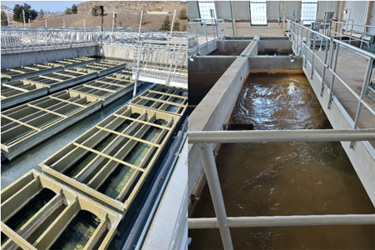WWEMA Window: Fully Automated Chemical Optimization For Drinking Water Treatment Gains Momentum
By Gregg McLeod, Hing Wong, and Jon Forrest

Drinking water treatment systems utilize chemical coagulants to assist in mitigating turbidity from surface source waters. In most cases, coagulant consumption is the largest operating cost within a facility. Over the past few years, coagulant prices have increased significantly, putting pressure on utilities to look for ways to reduce chemical consumption. Coagulants rely on certain conditions to perform, namely particle charge, pH, water temperature, turbidity, and organic level. However, the technology to optimize chemical performance is lacking in this industry.
Surprisingly, until now there hasn’t been a fully automated control feature that can regulate dosage, optimize process performance, and conserve chemical. FORTECH and Marmac Water partnered to install the first fully automated analyzer driven coagulant dosage system at the Salisbury-Rowan water treatment facility in North Carolina. The automated chemical dosing optimization system has been running successfully for over a year with significant improvement in plant performance while simultaneously reducing chemical demand.
Source Water Quality Issues
Like many drinking water treatment systems, variable source water quality pose a problem for operators, namely how to establish a proper dose of coagulant that will maintain clarification and filter performance. Inorganic coagulants such as aluminum chlorhydrate, which is utilized at Salisbury-Rowan, is pH dependent. The reaction of this coagulant is optimized within a certain pH range. This optimal pH range “shifts” with water temperature. Additionally, the demand for the coagulant is related to the influent turbidity (cloudiness). The demand for coagulant is directly related to the turbidity particle charge which traditionally has been measured by streaming current. Recent advances in particle charge measurement have evolved with the advent of automated zeta potential. A zeta potential analyzer can accurately determine coagulant demand to offset the influent turbidity. Combining optimum water temperature compensated pH with optimum zeta potential provides the basis for successful automated control. Marmac Water developed a patented coagulant dosing software that allows the optimized and fully automated dosing control of this critical chemical coagulant. FORTECH assisted in converting this specialized logic to a PLC-driven automated control system for Salisbury-Rowan Utilities.
Automated Chemical Dosing Logic: Analyzer-Driven vs. Machine Learning
Artificial intelligence has recently exploded into many areas including water treatment. Multiple companies are competing to implement data-driven chemical optimization. However, this approach will be limited by the following:
- Relies on past data to enact chemical dosing changes
- Water quality changes are not predictable
- Additional analyzer data cannot be incorporated
Fully Automated Chemical Dosing Control Automation Utilizing On-Line Analyzers
An alternative to data-driven software optimization utilizing existing inputs coupled with advanced analyzers, such as on-line zeta potential, achieves superior results. In the winter of 2021, FORTECH, working with Marmac Water, installed a PLC and HMI into an existing panel at the Salisbury-Rowan Utilities water treatment plant.
The importance of precise timing cannot be overstated when it comes to this type of control system. Due to the inherent delay between chemical feed changes and their interaction with water, any slight deviation in timing can have a profound impact on the system's performance. Thankfully, with the implementation of advanced PID loop control, the system can be specifically tailored to accommodate these unique challenges. The use of a combination of feedforward loop control, which enables the system to quickly detect and respond to any major system upsets, and feedback loop control, which continuously monitors and adjusts the process variables to maintain optimal performance, has further optimized the system.
The integration of these sophisticated technologies has ultimately led to the smooth and effective control of the system, ensuring that it operates at peak efficiency. Thanks to the precision and flexibility of the control system, performance is markedly improved, allowing for enhanced performance and cost-reduction.
After installation of the hardware components and on-line zeta potential analyzer, the Salisbury-Rowan Utilities water treatment plant benefitted from the following:
- Improved clarifier performance
- Extended filter run times from 50 to over 150 hours, conserving water and power costs, resulting in increased production
- Reduced operator attention especially during turbid rain events
- 50% reduction in chemical consumption
Sustainable, Green Technology
The LowDose™ chemical optimization solution is considered a sustainable, “green” technology that provides an attractive carbon footprint reduction. Marmac Water and FORTECH are presently working with several utilities that are seeking sustainable alternatives with an advantage of a rapid return on investment (ROI).
Gregg McLeod, PE, is President of MARMAC Water.
Hing Wong, PE, is an Engineering Manager at FORTECH, Inc., headquartered in Charlotte, North Carolina.
Jon Forrest is President of FORTECH. Forrest serves on the Water and Wastewater Equipment Manufacturers (WWEMA) Board of Directors and Marketing & Member Services Committee.
WWEMA is a non-profit trade association that has been working for water and wastewater technology and service providers since 1908. WWEMA’s members supply the most sophisticated leading-edge technologies and services, offering solutions to every water-related environmental problem and need facing today’s society. For more information about WWEMA, visit www.wwema.org.
